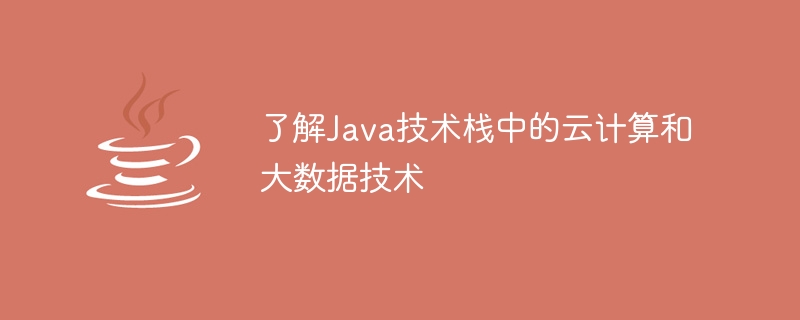

Understand cloud computing and big data technology in the Java technology stack
Cloud computing and big data technology are two very popular areas in today’s IT industry, and Java As a powerful and widely used programming language, it naturally also plays an important role in cloud computing and big data technology. This article will introduce common tools and technologies related to cloud computing and big data in the Java technology stack, and provide some code examples as a reference.
1. Cloud Computing Technology
Java Cloud Platform is a solution for deploying Java applications to the cloud. Currently, the more popular Java cloud platforms include Amazon Web Services (AWS), Microsoft Azure and Google Cloud Platform. These cloud platforms provide a wealth of cloud services, including virtual machines, databases, storage, message queues, etc. The following is a Java code example that uses the AWS S3 storage service:
import com.amazonaws.services.s3.AmazonS3;
import com.amazonaws.services.s3.AmazonS3ClientBuilder;
public class S3Example {
public static void main(String[] args) {
AmazonS3 s3Client = AmazonS3ClientBuilder.defaultClient();
String bucketName = "my-bucket";
String fileName = "my-file.txt";
String content = "Hello, world!";
s3Client.putObject(bucketName, fileName, content);
}
}Containerization technology is a method of packaging an application and its dependencies into A standalone container method. The most popular containerization technology in Java is Docker. With Docker, a Java application and related dependencies can be packaged into an image and run in any environment that supports Docker. The following is an example of using Docker to deploy Java applications:
FROM openjdk:11-jdk WORKDIR /app COPY target/my-app.jar . CMD ["java", "-jar", "my-app.jar"]
2. Big data technology
The distributed computing framework is Core technologies in big data processing. The most well-known distributed computing frameworks in Java are Apache Hadoop and Apache Spark. Hadoop provides distributed storage and computing capabilities, while Spark provides more efficient data processing and analysis capabilities. Here is a Java code example using Spark for batch processing:
import org.apache.spark.sql.Dataset;
import org.apache.spark.sql.Row;
import org.apache.spark.sql.SparkSession;
public class BatchProcessingExample {
public static void main(String[] args) {
SparkSession spark = SparkSession.builder()
.appName("Batch Processing Example")
.master("local")
.getOrCreate();
Dataset<Row> data = spark.read().csv("data.csv");
// 提取和转换数据
Dataset<Row> transformedData = data.filter("age > 18");
// 启动计算
transformedData.show();
spark.stop();
}
}Streaming processing framework is a technology used to process real-time data. The most popular stream processing frameworks in Java are Apache Kafka and Apache Flink. Kafka is a distributed message queuing system used to reliably transmit and store real-time data. Flink is a scalable stream processing engine that can calculate and analyze data streams in real time. The following is a Java code example using Flink for streaming processing:
import org.apache.flink.streaming.api.datastream.DataStream;
import org.apache.flink.streaming.api.environment.StreamExecutionEnvironment;
public class StreamProcessingExample {
public static void main(String[] args) throws Exception {
StreamExecutionEnvironment env = StreamExecutionEnvironment.getExecutionEnvironment();
DataStream<String> data = env.fromElements("Hello", "World");
// 数据处理逻辑
DataStream<String> processedData = data.map(s -> s.toUpperCase());
// 输出结果
processedData.print();
env.execute();
}
}The above are some common tools and technologies related to cloud computing and big data in the Java technology stack. By learning and understanding these technologies, you can better cope with the challenges in today's IT industry and develop more powerful Java applications in the fields of cloud computing and big data.
Reference materials:
The above is the detailed content of Understand cloud computing and big data technologies in the Java technology stack. For more information, please follow other related articles on the PHP Chinese website!
